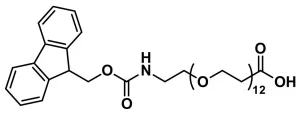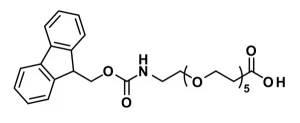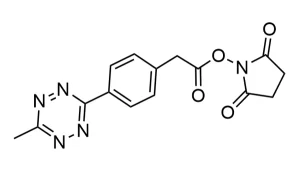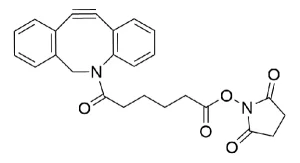Fmoc-N-amido-dPEG®8-NHS ester, product number QBD-10995 contains an Fmoc-protected amine on one end of a short (28 atoms), single molecular weight, discrete-chain-length polyethylene glycol (dPEG®) spacer and the N-hydroxysuccinimidyl (NHS) ester of a propionic acid group on the other end. This product is ready for the direct introduction of a water-soluble, amphiphilic spacer into a peptide chain without the need to activate the carboxylic acid moiety. The Fmoc protecting group on the N-terminus of the molecule cleaves easily with standard peptide chemistry.
Fmoc-N-amido-dPEG®8-NHS ester permits our customers to insert a short dPEG® spacer into a peptide chain using solid-phase or solution-phase chemistry. The dPEG® linker attaches at the N-terminal end of the peptide chain or on the free amine side chain of amino acids such as lysine. Additional peptide synthesis can be carried out to extend the peptide further, creating a peptide with a flexible, hydrophilic linker or spacer in the middle. Also, the dPEG® chain can provide spacing in a synthetic construct where steric hindrance is a problem. Amphiphilic, non-immunogenic dPEG® increases the hydrodynamic volume and improves the water solubility of the peptide while remaining soluble in organic solvents. The Fmoc protecting group is removed easily with a solution of piperidine in N,N-dimethylformamide (DMF).
| Unit Size | 100mg, 1000mg |
|---|---|
| Molecular Weight | 760.82; single compound |
| Chemical formula | C₃₈H₅₂N₂O₁₄ |
| CAS | 1334170-03-4 |
| Purity | > 98% |
| Spacers | dPEG® Spacer is 28 atoms and 32.2 Å |
| Shipping | Ambient |
| Typical solubility properties (for additional information contact Customer Support) | Methylene chloride, Acetontrile, DMAC or DMSO. |
| Storage and handling | -20°C; Always let come to room temperature before opening; be careful to limit exposure to moisture and restore under an inert atmosphere; stock solutions can be prepared with dry solvent and kept for several days (freeze when not in use). dPEG® pegylation compounds are generally hygroscopic and should be treated as such. This will be less noticeable with liquids, but the solids will become tacky and difficult to manipulate, if care is not taken to minimize air exposure. |
Greg T. Hermanson, Bioconjugate Techniques, 3rd Edition, Elsevier, Waltham, MA 02451, 2013, ISBN 978-0-12-382239-0; See Chapter 18, Discrete PEG Reagents, pp. 787-821, for a full overview of the dPEG® products.
Design of a modular tetrameric scaffold for the synthesis of membrane-localized D-peptide inhibitors of HIV-1 entry. J. Nicholas Francis, Joseph S Redman, Debra M Eckert, and Michael S. Kay. Bioconjugate Chemistry, 2012, 23 (6), pp 1252-1258, May 1, 2012. DOI: 10.1021/bc300076f.
Novel Synthetic Route to Peptide-Capped Gold Nanoparticles, Takeshi Serizawa, Yu Hirai, and Mamoru Aizawa. Langmuir. 2009, 25 (20), pp 12229–12234. September 21, 2009. DOI: 10.1021/la9021799.
Multivalent Benzamidine Molecules for Plasmin Inhibition: Effect of Valency and Linker Length. Tanmaye Nallan Chakravarthula, Dr. Ziqian Zeng, Prof. Nathan J. Alves. ChemMedChem, Volume 17, Issue 22, (2022), 09/16/2022, https://doi.org/10.1002/cmdc.202200364.
Applicable patents and legal notices are available at legal notices.




Stay in the Loop. Join Our Online Community
Products
Ordering
About Us
Application
Resources

©Vector Laboratories, Inc. 2025 All Rights Reserved.
To provide the best experiences, we use technologies like cookies to store and/or access device information. Consenting to these technologies will allow us to process data such as browsing behavior or unique IDs on this site. Not consenting or withdrawing consent, may adversely affect certain features and functions. Privacy Statement
How do I Request a Quote?
To request a quote for products: